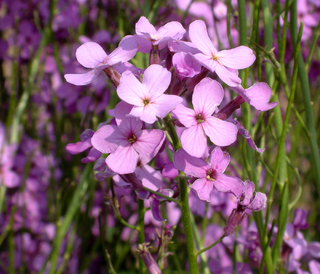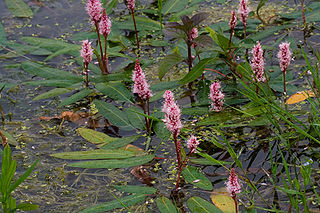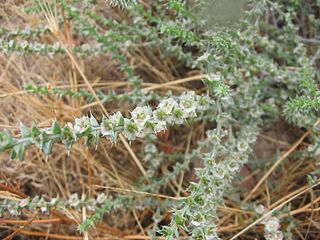
Brassicaceae or Cruciferae is a medium-sized and economically important family of flowering plants commonly known as the mustards, the crucifers, or the cabbage family. Most are herbaceous plants, while some are shrubs. The leaves are simple, lack stipules, and appear alternately on stems or in rosettes. The inflorescences are terminal and lack bracts. The flowers have four free sepals, four free alternating petals, two shorter free stamens and four longer free stamens. The fruit has seeds in rows, divided by a thin wall.

In botany, a bulb is structurally a short stem with fleshy leaves or leaf bases that function as food storage organs during dormancy.

Pulmonaria (lungwort) is a genus of flowering plants in the family Boraginaceae, native to Europe and western Asia, with one species east to central Asia. According to various estimates there may be between 10 and 18 species found in the wild.

Hesperis matronalis is an herbaceous flowering plant species in the family Brassicaceae. It has numerous common names, including dame's rocket, damask-violet, dame's-violet, dames-wort, dame's gilliflower, night-scented gilliflower, queen's gilliflower, rogue's gilliflower, summer lilac, sweet rocket, mother-of-the-evening, Good & Plenties, and winter gilliflower.

Leucospermum is a genus of evergreen upright, sometimes creeping shrubs that is assigned to the Proteaceae, with currently forty-eight known species.

Elodea canadensis is a perennial aquatic plant, or submergent macrophyte, native to most of North America. It has been introduced widely to regions outside its native range and was first recorded from the British Isles in about 1836.

Dipsacus fullonum, syn. Dipsacus sylvestris, is a species of flowering plant known by the common names wild teasel or fuller's teasel, although the latter name is usually applied to the cultivated variety D. fullonum var. sativus. It is native to Eurasia and North Africa, but it is known in the Americas, southern Africa, Australia and New Zealand as an introduced species.

Spiranthes spiralis, commonly known as autumn lady's-tresses, is an orchid that grows in Europe and adjacent North Africa and Asia. It is a small grey-green plant. It forms a rosette of four to five pointed, sessile, ovate leaves about 3 cm (1.2 in) in length. In late summer an unbranched stem of about 10–15 cm (3.9–5.9 in) tall is produced with approximately four sheath-shaped leaves. The white flowers are about 5 mm (0.20 in) long and have a green spot on the lower lip. They are arranged in a helix around the upper half of the stalk. The species is listed in Appendix II of CITES as a species that is not currently threatened with extinction but that may become so. Autumn lady's-tresses are legally protected in Belgium and the Netherlands.

Astartea is a genus of flowering plants in the myrtle family, Myrtaceae. The genus is endemic to southwestern Western Australia. The genus name was inspired by Astarte, the Greek name for the goddess Ishtar.

Platystemon is a monotypic genus of flowering plants in the poppy family containing the single species Platystemon californicus, which is known by the common name creamcups. It is native to Oregon, California, Arizona, Utah and Baja California, and is found in open grasslands and sandy soils below 6,000 feet (1,800 m) elevation.

Wachendorfia is a genus of perennial herbaceous plants that is assigned to the bloodroot family. The plants have a perennial rootstock with red sap. From the rootstock emerge lance- or line-shaped, sometime sickle-shaped, pleated, simple leaves set in a fan, that are flattened to create a left and right surface rather than an upper and lower surface. The leaves die when the seeds are shed in three of the species, and are perennial in one species. The rootstock also produces flowering stems annually that carry a panicle of zygomorphic, yellow or yellowish flowers in two distinct forms, one with the style and one stamen bent to the right and two stamens to the left, and vice versa. The fruit opens with three valves and each contains a single, hairy seed. All species only occur in the fynbos biome in the Cape Provinces of South Africa.
This page provides a glossary of plant morphology. Botanists and other biologists who study plant morphology use a number of different terms to classify and identify plant organs and parts that can be observed using no more than a handheld magnifying lens. This page provides help in understanding the numerous other pages describing plants by their various taxa. The accompanying page—Plant morphology—provides an overview of the science of the external form of plants. There is also an alphabetical list: Glossary of botanical terms. In contrast, this page deals with botanical terms in a systematic manner, with some illustrations, and organized by plant anatomy and function in plant physiology.
Important structures in plant development are buds, shoots, roots, leaves, and flowers; plants produce these tissues and structures throughout their life from meristems located at the tips of organs, or between mature tissues. Thus, a living plant always has embryonic tissues. By contrast, an animal embryo will very early produce all of the body parts that it will ever have in its life. When the animal is born, it has all its body parts and from that point will only grow larger and more mature. However, both plants and animals pass through a phylotypic stage that evolved independently and that causes a developmental constraint limiting morphological diversification.
This glossary of botanical terms is a list of definitions of terms and concepts relevant to botany and plants in general. Terms of plant morphology are included here as well as at the more specific Glossary of plant morphology and Glossary of leaf morphology. For other related terms, see Glossary of phytopathology, Glossary of lichen terms, and List of Latin and Greek words commonly used in systematic names.

Kali tragus is a species of flowering plant in the family Amaranthaceae. It is known by various common names such as prickly Russian thistle, windwitch, or common saltwort. It is widely known simply as tumbleweed because in many regions of the United States, it is the most common and most conspicuous plant species that produces tumbleweeds. Informally, it also is known as "'salsola", which was its generic name until 2007.

Persicaria amphibia is a species of flowering plant in the knotweed family known by several common names, including longroot smartweed, water knotweed, water smartweed, and amphibious bistort. It is native to much of North America, Asia, Europe, and parts of Africa, and it grows elsewhere as an introduced species and sometimes a noxious weed.
Streptanthus insignis is an uncommon species of flowering plant in the mustard family known by the common names plumed jewelflower and San Benito jewelflower. It is endemic to California, where it is known only from the Inner Central Coast Ranges. It grows in grassland and chaparral habitat, usually on serpentine soils. It is an annual herb producing a hairy, bristly, branching stem up to about 60 centimeters long. The lance-shaped basal leaves are borne on short petioles. Leaves midway up the stem are longer, and those near the top are shorter. They sometimes clasp the stem at their bases. Flowers occur at intervals along the upper stem. The uppermost flowers are often sterile and different in form. Each fertile flower has a bell-shaped calyx of sepals which is purple or greenish-yellow depending on subspecies. The petals at the tip are purplish or yellowish, also depending on subspecies. The fruit is a flat, straight silique which may be over 11 centimeters long.

Kali is a genus of plants in the subfamily Salsoloideae in the family Amaranthaceae. Common names of various members of this genus include buckbush, rolypoly, tumbleweed for its wind-blown seed dispersal habit, and Tartar thistle and Russian thistle for its origins.
Catananche lutea, is a woolly annual plant, in the family Asteraceae, with most leaves in a basal rosette, and some smaller leaves on the stems at the base of the branches. Seated horizontal flowerheads develop early on under the rosette leaves. Later, not or sparingly branching erect stems grow to 8–40 cm high, carrying solitary flowerheads at their tips with a papery involucre whitish to beige, reaching beyond the yellow ligulate florets. Flowers are present between April and June. This plant is unique for the five different types of seed it develops, few larger seeds from the basal flowerheads, which remain in the soil, and smaller seeds from the flowerheads above ground that may be spread by the wind or remain in the flowerhead when it breaks from the dead plant. This phenomenon is known as amphicarpy. The seeds germinate immediately, but in one type, germination is postponed. It naturally occurs around the Mediterranean. Sources in English sometimes refer to this species as yellow succory.

Babiana hypogaea is a perennial plant of about 5–8 cm (2.0–3.1 in) high that annually forms leaves and flowers from an underground corm that is assigned to the iris family. It has pale greenish yellow, buff or rarely white, mirro-symmetrical flowers and line- to sickle-shaped, slightly pleated, thinly hairy or hairless leaves that are held horizontally or inclined, that grows in the summer rainfall areas of southeastern Namibia and central and northern central South Africa. Flowers may be found between June and September and sometimes between December and May. It is called Bobbejaankalkoentjie, Bobbejaanuintjie or Ertappeluintjie in Afrikaans.















